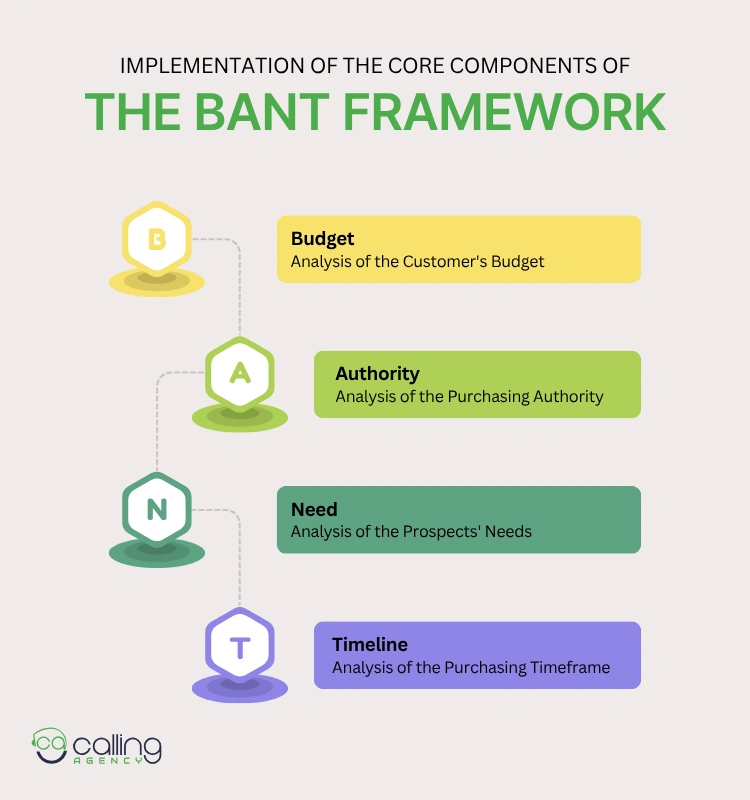Strategically qualifying the sales leads is one of the crucial tasks for the sales team of any business. Here, the BANT framework plays an effective role. You can easily qualify the leads by analyzing the customer’s budget, authority, need, and purchase decision-taking timeline in this sales framework. In this article, we will discuss these core factors of BANT more descriptively to help you understand them and use them for your sales growth.
Our core discussion parts will be the right implementations of these core factors –
- Budget – Properly analyzing the financial resources of the customers.
- Authority – Decision-making ability of the potential customers.
- Need – Examine the specific demands and pain points of the customers regarding products and services.
- Timeline – Decision-making timeline of the customers.
Additionally, we will discuss how you can benefit from this framework and the potential challenges of it. So let’s explore it properly.
What Is the BANT Framework?
Well, BANT is a short form of budget, authority, need, and timing. It’s considered a sales qualification framework that helps the salespeople qualify the sales prospect.
“The BANT framework was first developed by IBM in 1950. Then, it was gradually practiced by multiple companies and organizations, because of the improved power of the sales teams’ working process.”
Here is a valuable document that IBM provided regarding the BANT process.
Here are some factors that the salespeople highly focus on in the BANT process:
- The prospect’s overall budget. Is the prospect financially capable of purchasing the product or service?
- The prospect’s authority to purchase. It explains the decision-making ability of the prospects or the power to select the product or services.
- Determine the needs of the prospects. The need means that the potential customer has a requirement or any queries about the product.
- The timeline or urgency of the customer. It means how fast the customer wants the product or services from you.
So this process or framework is a complete analysis of customers’ requirements and demand. That provides you with a complete and clear picture of customers’ purchasing decisions.
Most of the lead generation service providers follow the BANT framework to boost the efficiency of their sales team to get qualified sales leads.
Here the salespeople go through proper analysis if the customers is he or she are capable or interested in purchasing the product or services.
In the next section, we will discuss the core components of the BANT in more detail. It will help you to understand the overall framework more accurately.
Implementation of the Core Components of the BANT Framework
The major components of the BANT framework or formulas are budget, authority, needs, and timeline. It helps the salesperson to qualify their potential customers easily.

As a result, businesses will get the right customers, who are reliable. Also, it has an impact on the long-term growth of the business. So let’s get a complete idea about all the core components of the BANT.
Budget – Analysis of the Customer’s Budget
Determining the budget of the customer is the initial component of this formula or framework. Without deciding the budget, it’s very difficult to determine whether the customer is he or she is capable of being a customer.
For the budget analysis, you have to focus on some essential factors. Such as –
- Evaluating the Financial Capability – First, you have to understand and examine if the customer has sufficient financial resources for buying the product or service.
- List out the Qualified Prospects – After understanding the financial resources, you have to list out and identify them. Those who have the financial ability and resources to purchase the product.
- Remove the Unnecessary Prospects – According to the budget analysis, you can easily understand that some of the customers are not capable of purchasing the product. So you can easily remove them from the list. Also, it will save significant time in qualifying the sales prospects.
For analysing the budget, you can ask the following questions. It will help you to clarify the prospect’s budget more accurately.
- How much ROI(Return on Investment) do you expect from this purchase or project?
- What are your allocated financial resources for solving the current issues that you want to overcome?
- Are there any limitations regarding your overall expense structure?
- Is the pricing structure suitable for you to solve the issues?
- How do you compare it with your projected solution cost?
There is another factor that you should carefully focus on in the budget analysis process. You have to go through a complete analysis of the prospect’s current spending structure. How much are they spending on their current business in terms of purchasing products or services?
So, follow these analyses to easily determine the budget part of the BANT.
Authority – Analysis of the Purchasing Authority of the Customers
In the BANT framework, authority means the decision-making power of the potential prospect. It will help you to understand that the prospect is capable of making the purchasing decision. So, along with the budget, authority is another valuable element of the BANT.
Somehow, the authority is more important than the budget. Because if prospects are highly interested in purchasing the product, they must invest the money in your product or service.
As a salesperson, you have to follow these factors to analyze the authority part.
- Signifying the Decision Makers – In the authority analysis part, identifying the decision makers is highly important. You have to find out who the actual decision makers are for taking the final decision to purchase the product.
- Communicate with Core Stakeholders – Another important factor is that you have to communicate and connect with the stakeholders because most of the companies’ purchasing authority depends on the stakeholders’ decision.
- Focus on the Sales Efficiency – Individual customers’ or companies’ sales efficiency is related to their authority to purchase the product or services. The frequency of the sales metric will help to get an idea of their authority.
Here are some questions that you should ask and analyze during the authority phase.
- Who are the primary decision makers for making the purchasing decision for the company?
- Who are the core users of the products and services?
- Are there any stakeholders or persons who are directly involved with making the purchasing decision?
- Have they purchased similar products or services before?
- Do they have any potential roadblocks or objections in the phase of taking the purchasing decision?
Need – Analysis of the Prospects’ Needs or Painpoints
Need analysis means identifying the potential customer’s goals, pain points, and challenges. Also, you must have examined why they are interested in your products and services. So, clarifying the customer’s needs is highly necessary to meet their demands.
Here, your main goal is to clarify the core requirements of the prospects.
- Explore and Realize the Pain Points – Your first task of the “Need” section is to identify the customer pain points. You have to analyze what type of problems they are facing right now. Then, align them with how your products and services will solve their problems.
- Strategic Solutions – So, you have properly understood their pain points. Now your goal is to prepare your products and services aligned with their needs, so that they can provide them the right solution.
- Prioritization of the Customer Urgency – You have to remember that just providing the solutions to the customers isn’t your goal. Here are specific requests that might come from customers. Some of them might ask you for urgent customization or adding extra features to your product or service. So you have to prioritize them according to your business policy.
In terms of analyzing the customer needs, you must analyze and ask them these questions –
- What type of challenges are you facing, and how do they impact your business?
- What are their core objective that they want to achieve this year?
- What is your projected outcome from a new solution that might be products or services?
- What limitations are you facing with your current product or services that you are using right now?
- Have you ever searched for any type of alternative solutions that might solve your issues?
Timeline – Analysis of the Purchasing Timeframe of the Customers
Determining the timeline in the BANT process involves understanding how much time the customer will take to purchase the product or services. Here, one thing you have to remember is that your overall sales cycle should be synced with the customer’s purchasing timeline.
Otherwise, it will become a major issue for the entire BANT formula because applying the BANT process means qualifying the right prospects with the most time-efficient ways.
If there is any gap in the timeline, your sales growth will automatically slow down. These are some of the essential factors that you have to focus on in terms of timeline analysis.
- Structuring the Timeline – The prospects might have a specific timeframe for purchasing the products. But you have to analyze the timeline and structure it, syncing with your sales cycle. Also, it’s necessary to meet the prospect’s deadline on time.
- Finalize the Purchase Decision – You must ensure that you understand how long it will take the customer to make the purchase decision. By determining this, you can create a proper pipeline for the sales.
- Possibility Obstacles – During this decision-making period, there might be any type of obstacles. Some of the common obstacles are budget approvals, negotiations in the contract, priority changes, lack of transparency, etc. So you have to carefully focus on these factors and manage them.
For analysing the timeline in the BANT, you have to focus on these reliable questions to make it more flawless.
- What is your estimated timeline for taking the final decision?
- Are there any upcoming deadlines or tasks that might change your decision-making phase?
- Do you have any specific milestones that can be done in this decision-making period?
- What is your expected timeline, do you think, for getting the result from this solution?
Benefits of Using BANT for Lead Qualification
The BANT framework is specifically helpful for sales growth by improving efficiency and volume. Your sales team can easily grab the right leads and save a significant amount of time by following the BANT process.
In this part, we will discuss some of the core benefits of BANT. So let’s explore them one by one.
It Improves the Lead Qualification
The BANT process is mainly used to qualify the right leads within a short amount of time. So that the sales pipeline remains consistent. Sales lead qualification is a crucial task because you have to understand whether the leads are really effective for your business.
Here, this framework works in a more results-focused way. These are some of the core factors on how the BANT helps in improving the lead qualification for the sales team.
- The salespersons analyze the prospect’s financial resources to understand the ability to purchase the product and services. So it directly impacts the qualification of the leads.
- Proper authorization of the prospect’s decision-making process also helps you in qualifying the sales leads.
- Through the active analysis process, salespersons can easily understand that they really need the products and services.
- Another important factor in the sales lead qualification is the timeline. By following the BANT process, you can get an idea about how much time the customer will take to purchase the product.
Example – You have SaaS CRM tools for managing customer relationship problems of businesses. To get the right customers, you are asking the potential customers what type of problems they are facing in terms of customer management, their budget, and who makes the purchasing decision for buying these types of products.
BANT is Suitable for Sales Forecasting
Sales forecasting is always a crucial factor for the overall growth of any type of business organization. In this situation, BANT will give you a complete idea of the better projection of your upcoming sales growth.
Also, you will understand that you will create a proper sales strategy for the upcoming six months or a year.
Because, in this framework, your sales team already analyzes the customers through different factors such as their budget, authority to purchase, specific needs and demands, and decision-making timeline.
So, you have already got all the ideas about who your potential customers are and who will be the sustainable users of your products. Here, the confusion is almost gone because of following the BANT process.
Better Communication With the Potential Sales Prospects
Another powerful benefit of BANT is that it improves communication with the sales prospects. Because for the analysis, you are constantly communicating with the prospects through different methods.
Also, you are analyzing their activities, what type of products they are using, how the products help them, etc.
These are some of the focus points on how the BANT helps in building better communication with the customers.
- Personalized Massaging – After analysing the customer’s budget, authority, need, and timeline, you can create customized massages for the potential prospects. It will help you to understand the individual’s demands and priorities.
- Well-Structured Approach – When you have complete data of the customers, you can easily approach them with your product and services information that aligns with their demands.
- More Precise Communication – Your sales team already understands the customer’s situation through the BANT analysis. As a result, they can easily point out what the customer’s actual needs are. Here, their communication will be clearer and precise.
- Improvement in Collaboration – The frequent and detailed communication with the salespersons and the potential customers will automatically improve the collaboration. This collaboration will be good for the determining goals through working on the same page.
Efficient Use of Resources and Saves Time
As you already know, BANT is the most effective and time-saving sales framework. It’s often practiced by the sales team to qualify the right sales leads.
Your salespeople only identify and lock those sales leads that are convertible into permanent and reliable customers. This framework’s strategic filtration process goes through different stages.
Here, the customer prioritization becomes a core factor.
For example, you are communicating with a customer who is interested in purchasing your SaaS CRM tool. You know that this customer is already using a tool, but he didn’t get the expected benefits or perks from that tool. So, you can easily provide him with valuable resources regarding your tools and guides that might solve his current issues.
Here, one thing is happening that you don’t have to approach random people to promote your products and services.
You are just approaching only those potential customers who have a high chance of becoming your permanent customer. At the end of the day, it saves a significant amount of time and better uses resources.
Major Challenges and Limitations of BANT
Along with multiple types of benefits and perks, there are also some limitations in the BANT sales framework. In this part, we will show you a clear picture of the limitations and challenges of this framework.
| Challenges & Limitations | Explanation |
| Highly Focused on Transactional | The entire BANT sales framework is focused on transactional purposes. It’s mostly operated by the sales team, whose target is to grab only the right customers within a short time. So, sometimes the paintpoints and customers’ emotions become neglected. |
| Difficulties in Relationship Building | You only target those prospects who are already interested in purchasing your products. This highly filtered targeting process may open up the situation of losing the initial level of customers. |
| Lack of Flexibility | Because of the structured approach in the BANT framework, the lack of flexibility becomes a major issue. It might create conflict with the overall sales cycle. You are following a rigid checklist to get the sales leads faster. And you don’t have enough opportunity to communicate with the customers. |
| Lack of Opportunity to Educate and Nurture Customers | As the BANT process is highly focused on sales prospects. So, you will not get enough time and opportunity to educate potential customers with valuable resources. Because your sales team doesn’t have enough time to nurture the customers to build a long-term relationship with them. |
| Conflicts with the Overall Sales Cycle | One of the major challenges of the BANT process is that it creates conflicts with the sales cycle because this framework is highly focused on the single decision makers with an exact timeline. The B2B sales cycle is a long-term process of attracting and converting potential leads into a final customer. |
Final Words
So finally, we have come to the end of our article. Hopefully, you understand the implementation of the BANT process to get the most qualified customers. We have discussed how you can use the BANT strategy and its core factors, such as –
- Budget – Estimate the budget of the prospect.
- Authority – Authority to purchase the product from you.
- Need – Analysing the customers’ needs and pain points related to the product.
- Timeline – Purchase decision taking timeline of the customers.
Also, we have discussed the major benefits of applying the BANT and the common challenges & disadvantages that might come with this framework. This wholesome information will help you to use the BANT framework effectively and improve your growth and conversion rate.





